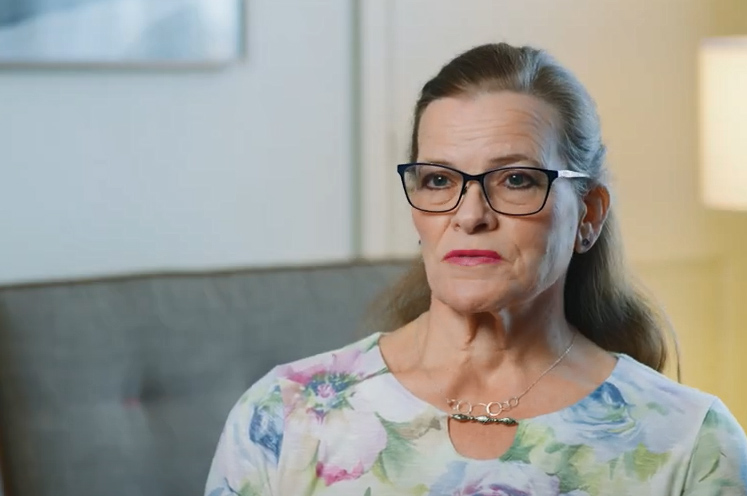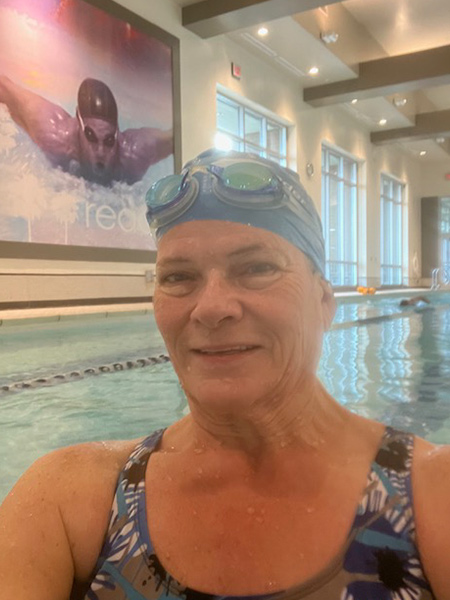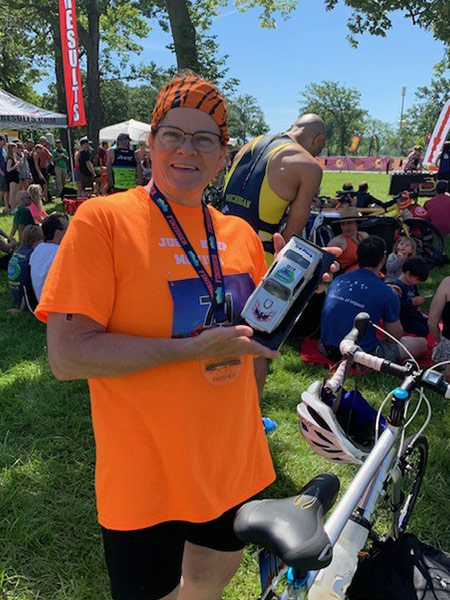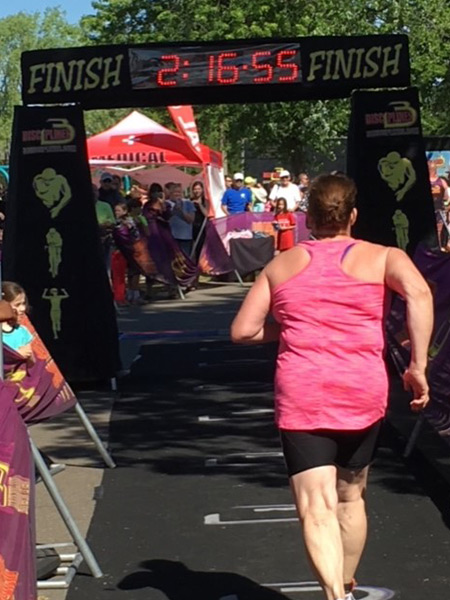The Other Side of the OR
At 60 years old, Catherine Hill, an operating room (OR) nurse, was familiar with the surgical setting. Then she experienced it as a patient.
 “In the summer of 2022 I started to have some stabbing pain on my lower back where my right kidney’s located,” says Catherine, a resident of Clinton Township who works full time at Henry Ford Medical Center – Lakeside. “I’d had kidney stones in the past and I work on some urology cases in my OR. I assumed this was just another stone, and I tried drinking more water to help pass it.”
“In the summer of 2022 I started to have some stabbing pain on my lower back where my right kidney’s located,” says Catherine, a resident of Clinton Township who works full time at Henry Ford Medical Center – Lakeside. “I’d had kidney stones in the past and I work on some urology cases in my OR. I assumed this was just another stone, and I tried drinking more water to help pass it.”
But it didn’t help, and the pain persisted.
“I met with Dr. Haddad in Henry Ford Urology and he ordered a CT,” Catherine says. “That’s when I found out it wasn’t a kidney stone.”
A more detailed CT scan with contrast (a dye that’s taken by mouth or injected through an IV to provide a clearer picture of the affected area) revealed that Catherine had an arteriovenous fistula (AVF) in her right kidney, a rare condition that had likely been there her whole life.
An AVF is an irregular connection that forms between an artery and a vein, rerouting blood flow. In Catherine’s case, the AVF had caused a massive aneurysm in her right kidney. A renal (kidney) aneurysm is a weakened area that causes a bulge in the wall of a kidney’s blood vessel. If it ruptures, it can cause significant blood loss, kidney failure or death.
“My case was even more complicated, because the abnormal blood vessels that had formed in my kidney were curvy and twisted,” Catherine says.
The diagnosis hit Catherine hard, and not just because she knew conditions like this from her work as an OR nurse. She also had a family history. Her aunt, father and grandfather all had aneurysms. In her grandfather’s case, he had died from an aneurysm—in his kidney.
A team collaboration
Ultimately, Catherine was referred to Timothy Nypaver, M.D., a vascular surgeon at Henry Ford Health who specializes in complex cases. They met at his Henry Ford Medical Center – Fairlane office in Dearborn, where they discussed options.
Typically, one of the first treatment options would be to remove the affected kidney, taking the aneurysm with it. However, this wasn’t an option for Catherine.
“I was already pretty much down to one kidney,” Catherine says. “My left kidney had been compromised when I was younger, likely due to an infection. It had shrunk, so I couldn’t afford to lose the right one. Another wrench in the works for my treatment plan.”
Dr. Nypaver ordered a renal study, a test that determines how well each kidney is functioning. The results showed that her right kidney was doing 70% of the work, and her tiny left one only 30%.
“He recommended that I get an embolization procedure,” Catherine says. “They would insert several tiny metal coils into the aneurysm to create a permanent clot that would stay there and block the abnormal blood flow.”
This minimally invasive procedure would be a collaborative effort between Henry Ford’s Vascular Surgery and Interventional Radiology teams. But first, they needed to get a clearer picture of Catherine’s aneurysm.
Dr. Nypaver performed an angiogram of her kidney, working in collaboration with David McVinnie, M.D., from the Henry Ford Interventional Radiology team. An angiogram involves inserting a catheter (flexible tube) into an artery and guiding it to the affected blood vessels, where X-ray images are taken. In Catherine’s case, the Henry Ford team used these images along with her CT scan to create an advanced, 3D reconstruction of her kidney. Her arteriovenous fistula and the aneurysm that it caused were like a puzzle, with her doctors trying to figure out which of the renal blood vessels were involved in the AVF and which ones supplied the kidney.
“This 3D reconstruction gave them a good visualization of where they were going to go, and how they were going to get there,” Catherine says.
The day arrives
 Catherine’s procedure was scheduled to happen several weeks later. In the meantime, she was instructed to manage her blood pressure and blood sugar levels.
Catherine’s procedure was scheduled to happen several weeks later. In the meantime, she was instructed to manage her blood pressure and blood sugar levels.
“This was another challenge,” Catherine says. “I have high blood pressure and I’m a type 2 diabetic. And since I work in an OR, there’s that added stress, not to mention the stress of preparing mentally for the procedure. But I knew I needed to get my body in fighting condition, so I worked to control my numbers.”
Dr. Nypaver also prepared Catherine for her surgery in other ways.
“He gave me several different scenarios on how the procedure might go,” Catherine says. “I knew that they would insert a catheter through my groin. But given the complexity of my case and where the aneurysm was located, he told me they might also need to insert an additional catheter in the jugular vein in my neck, and possibly through one in my side. They sterilized and shaved all these sites, just in case.”
For someone who was used to working in the OR, being on the operating table herself rather than next to it was an adjustment, especially given all the unknowns with her procedure. Fortunately, she had support.
“During my angiogram I had an OR nurse, Chenelle, who had been with me,” Catherine says. “She was there again for my embolization procedure. It was good to see a familiar face, and she held my hand and prayed with me before they put me out.”
When Catherine woke up four hours later in recovery, she started crying.
“My husband asked me what was wrong, but I was just so glad to be alive,” Catherine says. “As an OR nurse, I knew too much, and I think that made it twice as scary.”
She was also relieved to see that she didn’t have any dressings on her neck or side. Her surgical team was able to perform the surgery through the single puncture in her groin.
After Catherine’s follow-up CT scan a few weeks later, Dr. Nypaver told her that the implanted coils had stayed in place and everything looked good.
A new lease on life
“Before the surgery, I was restricted on exercise,” Catherine says. “This was hard, because I’m a very active person.”
In fact, in the years before the pandemic hit, Catherine was a sprint triathlete.
“It started when I turned 50,” Catherine says. “I had lost 100 pounds, and my son encouraged me to do something different. He got me into racing, and I lost another 20 pounds training for my first one. After that, I did the Motor City sprint triathlon every year, and everyone was used to seeing me ride my bike around. After my treatment, I’m reintroducing all of that back into my life and it’s wonderful.”
Given her family history, Catherine has also made it a point to talk to her sisters and two grown children about aneurysms and the importance of getting scanned.
“If there is one thing that I can share with people, it would be not to wait to go to their doctor when they have a gut feeling something’s not right,” Catherine says. “I was a walking time bomb, and I feel like I got a new lease on life.”
Catherine is also grateful to Dr. Nypaver and the rest of her Henry Ford Health team for everything they’ve done for her.
“My husband isn’t in a medical field, so he didn’t understand a lot of my condition,” she says. “Dr. Nypaver had the patience of Job and was cool as a cucumber during every step of this process. He would explain things until we understood everything.”
.svg?iar=0&hash=F6049510E33E4E6D8196C26CCC0A64A4)

/hfh-logo-main--white.svg?iar=0&hash=ED491CBFADFB7670FAE94559C98D7798)



